There are few email interviews I conducted that have been worth waiting for as much as this one. Here is my dialogue with the Polish artist, teacher, organizer and founder of UKRAiNATV, Roman Dziadkiewicz. Soon after we discovered this stream art channel on YouTube in the spring of 2022, I contacted Rom. We met soon after during my first ever visit to Poland/Warsaw in June 2022. The collaboration and friendship has been intense ever since, culminating in the recent launch of the Stream Art Network. So far, INC has published several essays on the politics and aesthetics of this unique Krakow-based multi-lingual scene, for instance this one by Konrad Wojnowski and another background text by Giulia Timis. There is also the UKRAiNATV Manifesto and one written by Rom himself. Recently, there is also an interview with the crew, made by Giada Dalla Bonta. This time I was interested in the origins of this stream art initiative as there is almost nothing known about the circumstances leaving up to the founding of UKRAiNATV, a week after the Russian full-scale invasion of Ukraine, late February 2022.
Geert Lovink: You have a background in painting and poetry. How would you describe your road from your classic art education in the turbulent 1990s to your video and performance work of today? I suppose you still had a communist upbringing. Did the Polish avantgarde of the 1970s had an influence on you? Or even on UKRAiNATV today? Is it fair to see such long lines of cultural tradition of underground art?
Roman Dziadkiewicz: I lost twenty plus years doing art, sabotaging myself and others because I was permanently thinking in critical ways: questioning the status of the artwork, the power dynamics within the art field, hypocrisy, institutions torn between the luxury goods market and social missions, and finally, about models of content production and distribution under the shadow of the digital revolution. If Stream Art hadn’t eventually evolved out of this, I’d probably be the most frustrated person within a 1000-kilometer radius today.
I decided to study painting (after graduating from a high school with a math and physics profile) because it felt like studying theoretical physics or mathematics—a pursuit of foundational knowledge and skills. It was like an elementary proving ground for observing, creating forms, and building models, entirely detached from reality—the innocence of a perception laboratory. Of course, that innocence doesn’t exist, so I quickly began combining this abstract practice with self-organization and questioning the social, political, cultural, and economic contexts of what we do and how/where it’s presented.
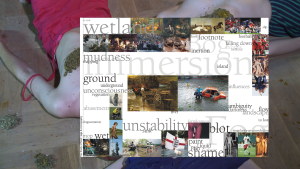
STUDY of MUD, 2008-13
At that time, in the mid 90s, the emerging art market and institutions in Poland and Eastern-Central Europe were far from innocent—I saw this from the beginning. So, we focused on self-organization, losing many battles while forming necessary and risky alliances. This mistrust of institutions is undoubtedly a long- standing tradition in our region. I participated in the last anti-communist protests and the first anti-capitalist, alter-globalist movements. From the very beginning, I critically observed the so-called development of the art market in Poland and Central Europe, along with the self-colonial fascination with institutional models and methods of cultural production and distribution. Today, we laboriously attempt to critique these systems, for example, within the Pacesetters project and others.
My background also includes experimental music, sports, some mathematics, and programming in high school. Images, touch, language, rhythm, and the body in motion. For a long time, I believed in art as a foothold—a laboratory of sensitivity and new ways of perceiving and showing the world. I believed in blending media, breaking their boundaries, sublimation, transgression, materiality, corporeality, freedom, and the sexual revolution in the post-communist context. I believed in dispersing authorship and creating temporary zones. “Believed” is a good word. The para-religious nature of art is a foundation upon which new illusions and delusions of agency are continually built.
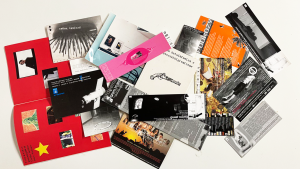
R. Dziadkiewicz archive (SAOZ, Fundacja36,6 and other prints 1994-2004)
Today, I no longer believe in anything. Neither do I believe in belief. But I also no longer need to believe—what was meant to happen has happened. And things continue to unfold—we’ve activated some kind of algorithm of connections, and truths are leaking out through the cracks of existence. Before studying at the Academy of Fine Arts, I was in a math and physics-focused high school. All my classmates went into IT. The revolution that began then continues to this day. I’m not speaking here about whether it’s good or bad—it’s a field of agency, real tensions, and struggles for influence. We were aware of this even then. A new space for work, play, and struggle emerged. There was a time for recognizing different positions and tactics, and maybe only now is the time for effective struggle. I hope to be part of it for the rest of my life.
https://www.academia.edu/25362037/Imhibition_National_Museum_in_Krakow_2006
I don’t believe in anything—but I see a lot. And that painting and poetry background probably taught me, above all, to look intensely and not fear contradictions. I see cracks and connections—infrastructure, cold people, and hot machines—all in a state of inertia, chaos, decay, and the potential for new combinations. Stream art is increasingly less about art and more about being a pure medium in itself. It’s also a pretext to step outside the field of art. We are becoming more mediators than artists, hope. Inspirations: The avant-garde of the 1970s, always. And jazz! Much more than anything that came later in local scene—the 1980s and 1990s, so-called critical art, or the painting of my peers. Also, new-school rap (that artificial kind, with autotune, created by privileged kids on Xanax around 2014+; I love it!), and new music from the last 5–10 years—hyper-pop, deconstructed EDM with its over-the-top AV / post-internet aesthetics and queer ethics.
From the 1990s, grunge and rave culture OC. But most of all, the people I’ve worked and lived with over the past 20+ years. Here, there should be an entire page of names, nicknames, first names, and portraits of people without whom there would be no Stream Art or UKRAiNATV. Some would probably be surprised that I remember them or want to remember them, but there are a few moments totally worth mentioning. It’s also good occasion for some conclusions. SAOZ and Fundacja36,6 had solid websites from the beginning (1999/2003), archives of texts, and documentation of social, artistic, and workshop activities. It was inspired by Indymedia. We went to the World Social Forum in Mumbai (2004) and wanted to connect knowledge production, working with information, and urban activism. Later, between 2011 and 2016, we formed ENSEMBLE, an open collective that began its activity as part of the local Krakow version of the Occupy the Streets movement but did much more „abstract” and absural activities then and very sensual in the same time…
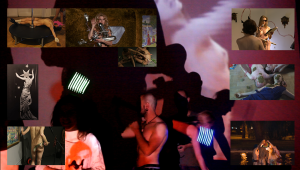
ENSEMBLE, Documentation and Iconography, 2011-14
We occupied an artificial island in a park during a public art festival, and later, we swept through several art and culture institutions—censored, kicked out from festivals, and seeking non-normative spaces for radically unconventional projects like “Orgies” or multi-hour improvisational collective trance performances — art-raves in a way. Some of these were also streamed on sex-cam platforms because there was no other options then. The amazing Joanna Bednarczyk from our team, a playwright, writer, and director, created the monodrama “Malina” and we played it in a hybrid way on the stage and at the ShowUp.tv platform. It was directly based on the experiences, monologues, and choreography of cam-girls, which was a big inspiration. Also reality TV, or Jennifer Ringley… Finally I finished this period with an undefended habilitation, dismissed by a conservative professor-censor from the Poznań Academy of Fine Arts and a rich archive, and some conclusions about the connection between gaze and touch. Next was “Superfisiology” (National Museum Krakow, 2015-16), an artistic-research project, series of interventions into the museum and science-fiction book.
https://uap.edu.pl/wp-content/uploads/2017/05/DZIADKIEWICZ_AUTOREFERAT_e.pdf

SUPERFICIOLOGY, 2015-16
GL: There are always pre-histories. This is also the case with UKRAiNATV. You had experiences before with running art foundations and independent structures. Then you started the Stream Art Studio out of a space next to the Krakow art academy where you teach. Streaming media have been around in the internet context for a long time, at least 25 years. However, these days it associated mostly with YouTube, Facebook Live, Twitch, FaceTime and then there also Skype and Zoom. There was a lot of streaming happening during the Covid period but only very few could be called experimental. What were your examples? In popular culture we have seen an opposite tendency: high production value Instagram and Tik-Tok clips of 30 seconds. Against this you’re offerering live ambient video enviroment of 3 hours+.
RD: Experimental is sometimes a good excuse for clumsiness and carelessness, from which unexpected discoveries occasionally arise. A lot happens outside of intentions. And the goal might be a 24/7 multi-channel hub, connecting inputs for the Stream Art Network, broadcasting content from various studios, places, and collectives collaborating to build the network. Real-time, remote joint productions. A dynamic schedule with fixed points and multi-directional collaborations. Or maybe the opposite—a complete dispersion and decentralization. I don’t know. What I do know is that there’s a lot of space and content to process, reinterpret, and explore in the process—learning by doing… A total bifurcation? The fact is, creative revolutions and innovations over the last 2–3 decades have largely taken place outside the field of art. Their products are annexed by art and often subjected to fascinating critical reflection. But compared to the gestures of the early 20th-century avant-garde, fewer and fewer moves within the art field are changing how the world beyond it is perceived. The digital revolution was slept through by art, and this needs to be said out loud. Of course, there are artistic individuals who experience it in their own way, trying to bring it into the art world. But it’s usually futile, heroic, laughable, clumsy, or naive. Incompetence gives rise to irony and post-irony, or pseudo-nihilistic poses. Yet, sometimes, from that careless naivety, something unexpected emerges—like stream art itself XD. Meanwhile, the world is changing at an avalanche pace.
The frameworks of art institutions and markets, the logic of authorship, the artist and their career, or the artwork as a value in itself—all these are inventions of a different era, cultivated by the luxury goods market and more and more corrupt institutions. Not that they can be blamed—they’re just trying to survive, like the church after the French Revolution. Art education, meanwhile, reproduces outdated schemes and illusions about the role of the artist and art from 50 years ago, feeding them to young people while paradoxically amplifying social media’s narrative of individual careers…
To be sure – it’s not personal. It’s not an attack on poor, creative people stuck in the art field (curators, artists,…) — more homeless by the day, yet rich in new skills and tools borrowed from other disciplines. Quite the opposite. This is a cry for change, a demand for structural shifts that could give them a chance to work with dignity—if the art field still wants to uphold its ethos as the most refined outpost of the avant-garde. We need systemic reform. We need to confront the systemic pathology that stems from the art field’s separation into narrow specializations, its disconnect, and incompetence in addressing contemporary needs. Think of this as a case study in the broader conservative turn among cultural elites. A bit like the German car industry: 50 years ago, the epitome of modernity, now a symbol of boomer inertia. Art—something that, throughout human history, was either a creative and communal way to spend free time or a set of magical practices—has turned into a luxury commodity locked inside institutional frames.
Sure, we need to critique the social media platforms. But unlike the pathology of the art field, the internet offers a battlefield. It is a messy, capitalist democracy type of struggle, with creative ferment and the proliferation of new phenomena. Meta-modernist creation of new categories. A space for a lot—yes, in the shadow of censorship, appropriation, and formatting—but still a battlefield. TikTok, YouTube, digital infrastructure, and post-MTV pop culture are undoubtedly important contexts for us. Everyone can be a creator here—paraphrasing J. Beuys—and monetize their digital presence. But the statistics are ruthless. So, either play, have a mission, or perish. We’re both playing and on a mission, what gives power…
Why aren’t there experimental contents? Maybe it’s a category from a different order. Perhaps, in a space where quantitative parameters define visibility, the experiment disappears. It’s there but incredibly hard to spot. Corrupted by the reach economy, we start fighting for visibility instead of focusing on experimentation and working on new QUALITIES. Maybe what awaits us soon is the task of building a new value system based on entirely new parameters and observing influence—understanding who really governs imagination and what actually changes perception.
Art is doing just fine, much like religion in its small bubble, because institutionally, it supports clearly outlined hierarchies of values. But this is yet another reason to see how conservative and ossified art has become in its rules within the broader social landscape. Ultimately, maybe it doesn’t matter what it looks like. Output is just a side effect of many mixed inputs and isn’t that important. In this process, the dynamics and constant mixing, in which we lose ourselves, are the environment, the path, and the goal. We circulate, reconciled to the fact that there’s no point in struggling, no destination to reach. It’s better to stay and dance on the spot, spin in circulatory entanglements, than set off on yet another distant expedition to discover and conquer new territories. And then there’s the matter of tool —non-human network actors, to paraphrase Object-Oriented Ontology philosophers. The studio setup, green box, software and hardware, generative elements, AI, or analogue loops—they have their own agency. We accept that and engage in this human-non-human dialogue—sometimes as secondary players, open to influence or even fascinated by this state of immersion, distortion, and bombardment. Sometimes, the hardest thing is to press the “end stream” button—that’s why our broadcasts last so long… But seriously, we’re connected to multiple sources simultaneously, and the content is constantly being created – a freedom of pixels.
It is also about the free movement in-between separated gaze and touch, past and present. It’s very possible that the invention and institutionalization of the past is the greatest invention of modernity—the foundation of a social order built on control. But maybe there’s still a subversive power in touch (even the touch of a screen), in reconfiguring the environments we inhabit. And maybe we can move with more boldness, OPERATING toward dismantling these regimes of passivity, consumption, objectification, and the hypnotic stare at the things surrounding us…
This is what stream art is about, too—about plugging in together and creating a permanent present, konsumcji, uprzedmiotowienia I gapienia się na otaczające nas przedmioty… O tym jerst też stream art – o takim podłączaniu się wspólnie I tworzeniu permanentnej teraźniejszości.
Latencja Studio, CYBERNETIC OPEN-AIR, 2020
GL: UKRAiNATV emerges at the end of an exhausting eight years of Catholic conservatism in politics, media and culture. I also associat e its energy and aesthetics with the feminist protests in Poland in 2020-21. Simulaneously there were the massive protests in Belarus, followed by the crack down of the moment and the exodus of tens of thousands of young people, many of which ended up in Poland. And then came the Russian invasion of Ukraine on February 24, 2022. Not a very quiet Covid period… Is it correct to see all these events flowing into the format of UKRAiNATV?
RD: Metacrisis was the environment that birthed successive iterations of the studio, hybrid experiments, and Stream Art. Streaming and hybridity had been lurking in the background of many performative and collective actions I co created over the past dozen or so years, as I’ve mentioned before. Right before COVID, I had a short but very pivotal stint with a post-rap collective—a performance, pop-culture, and new media experiment cheekily named SPLNDR. Post-ironic lyrics, a slay vibe, and a mishmash of orders. We collaborated with local music and AV producers, creating music videos, short films, concert-performances, songs, album covers, merchandise and similar art-pop frills. We released a tape, organized a few legendary events. Of course, there was some drama that still hits me with ricochets to this day—someone fought with someone else, some people still don’t speak to each other, and one person very dear to me passed away… Classic small-town reality. Back then, there was this persona, ArTVstka—a boss girl with immense courage and aesthetic instincts worth developing, even though most of the community mocked them (just like they later did with stream art experiments).
Then COVID hit, and then the war in Ukraine, locking me in the studio for the rest of my life. I need to mention two eternal Intermedia students, too – Wojtek Ratajczak and Bernard Śmiałek—who’ve been incredibly important to me then. I learned a ton from them (and I hope they picked up something from me, too). A lot of studio hours were spent with the queer diva Joanna Parniewska, baby-doll Wronika Baran, or Anastasiia Vorobiva, with whom we racked up hundreds of hours combining real-time production, in-studio performance, and Unreal 3D worlds. At the very start of UKRAiNATV, invaluable technical and conceptual input came from Erwin Jeneraczyk, Napoleon Bryll, and Aneta Sieniawska.
Latencja Studio (Rom Dziadkiewicz, Joanna Parniewska, Anastasiia Vorobiova), PHARMAKEIA, 2021.
COVID and conservatism accelerated one another. Let’s not forget that in Central Europe—Poland, specifically—the other side of the opposition isn’t “progressives” but liberals. From the perspective of local capital scarcity, liberals have always been dubious agents of global neo-colonial capital. Sure, they gave us a fleeting sense of first-world access, but at an enormous social cost—especially in the country’s provinces. It also came with a certain privileged isolationism, the effects of which we’ll increasingly feel. And art has always been a space for the liberal crowd to polish their images. Because of this, I’m increasingly offended by Polish institutions and art circles—they’re cowardly, opportunistic, and increasingly derivative. Post-colonially obsessed with the institutional models of the mythical West for the past 30 years, or simply alternative – chasing some Insta-underground Berlin-Athens like junkies dirty vibe taken from Instagram finally. It’s also quick to attach itself to socially valuable initiatives—like anti-abortion protests or the mass protests against ACTA in Poland. Among these, the Belarusian protests stand out as deeply significant to me. I was there a year earlier, met many people in Minsk within creative and socially engaged circles. They told me back then that soon, we’d be learning from them how to live and operate under regimes controlling our every step. Yeah, the Chinese model as the avant-garde of managing life in the future, lol.
GL: Is there a special performance tradition or practice you see at work here? I see the performances as the core practice of UKRAiNATV, not so much critical discourse or alternative journalism. There is a tactical media approach but it’s definitely not a politically correct talk fest.
RD: For me, the foundational tradition for a long time was relational art and relational aesthetics from the 90s. It shifted the focus to process and the role of institutions as spaces for fostering social and political reflection, as well as research-based practices, rather than merely showcasing finished products. But over time, I realized that relational aesthetics often boiled down to playing around, cooking curry, and nurturing the mutual interests of a small, privileged circle rather than driving real change or fostering openness. It was more the last gasp of a traditional, self-contained, self-disciplining performance framework than any kind of breakthrough.
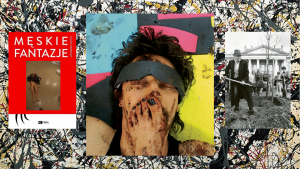
Study of Mud, 2008-13
I hold a particular grudge against that formation (which I guess I’m part of) because it came closest to challenging institutional frameworks and expanding relational philosophy to include non-human actors and non-art elements. From there, it was only a small step to a new model of cultural institutions—one breaking away from the gallery, the white cube, and the exhibition as the ultimate dispositive. The white cube won’t disappear, of course—just like the church didn’t vanish after the French Revolution. It’s a sublimation of the factory, refocused on producing and displaying luxury goods—and these won’t go away either. If anything, they’ll multiply in our gadget-obsessed culture.
https://placecalledspace.org/content/superficiology-by-roman-dziadkiewicz/
What we’re doing (and what many people and collectives have been tentatively experimenting with in the nooks of the internet for the last 30 years) requires new frameworks. Maybe the value and meaning of what we do lie in the fact that it’s a mash-up: performance, journalism, experimentation, foundational work with archives—and ultimately, a kind of prototyping for a new institution and new ways of presenting things / streams / data. Exhibition strategies for the age of meta-crises. Freeing oneself from authorship and freeing pixels, freeing digital matter, electron streams… Post-digital fauvism. And I have always had a weakness for fluid metaphors of matter – mud, bodily fluids and the states in between, the formlessness that bursts and questions modern orders (or their apparent dominion). Also white man condition, these all Male Fantasies follow Klaus Theweleit and self-reflection, bi-sexual, gender-fluid intuitions… Still, then and now we’re constantly askin questions and uncovering potentials we can’t fully exploit. We’re running loads of “stream-tests”—to riff on Andy Warhol’s concept of “screen-tests.” Maybe there’s less critical discourse in what we do, but definitely a lot of critical practice. We’re working with form and content (narratives), with information and energy (and its carriers). Our biggest challenge lies in placing our dynamic practices within the frameworks of the “exhibition” in a white cube or the authorship model. It just doesn’t fit.
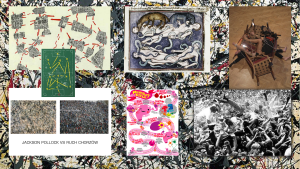
STUDY of MUD, Iconography, 2008-2013
GL: After 1989, with the membership of EU and NATO one can notice a shift inside Europe towards the East. In military terms this is first of all a defensive move, again Putin’s Russia and its aggressive strategies towards the West, including Poland. For decades the cultural orientation of Poland has been on the UK and US. But then there is suddenly UKRAiNATV, coordinated out of Krakow, mixing Polish, English, Ukrainian and Belarussian languages. How do you read this in terms of aesthetics, fear, traumas? Russians are absent in the mix. This may sound obvious at first. Please sketch us the deep psychology here in terms of history but also how the current young generation deals with this.
RD: We’re still debating this. Russian pops up sometimes—it used to appear more often—and always for a justified reason. Maybe someone fled Belarus and only speaks Russian, or someone grew up in Odessa, speaks Russian, Polish, English, and German, but when they want to talk about their childhood—the one they dream about in Russian—they insist on doing it in Russian, almost masochistically, knowing they’re exposing themselves (and us) to the ostracism of certain radical Ukrainian circles. Our team’s had its fair share of conflicts around this. Right now, we’re working on a piece where the theme of the Russian language (and people, including rappers from Crimea) resurfaces. The is still a debate with pro-Palestinian activists with Ukrainians ,or post-soviet girls totally distrustful of any smell of religious and conservative independence movement…
Without a doubt, we’re living in an increasingly multicultural Poland again, in increasingly multicultural cities. What’s interesting and important is that this isn’t the same kind of multiculturalism built on colonial dependencies or precarious dreams, like in Amsterdam, London, or Paris. It’s more like a reconstruction of the original, regional multiculturalism of Central and Eastern Europe—our own cultural melting pot, where national borders were arbitrarily drawn after World War I and II. Unlike Western European cities, which always had one dominant language and culture, in Eastern Europe, languages always mingled, and neighborhoods coexisted—Jewish, Armenian, German, Polish, Ukrainian, Czech, Russian, Silesian (and other local majorities, and local dialects). Kraków, for example, was built by German merchants and local nobility on on foundations from the times of the influence of Kievan Rus and the Great Moravian State, then rebuilt by Italians and Lituanians. Always patchwork full of alchemics, dragons and other strange hybrids…
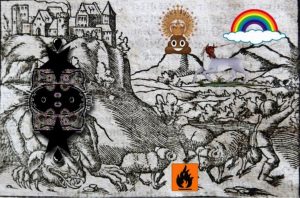
SPLNDR post-meme archive, 2019
There’s still so much ahead of us—not just in the scope of our small UKRAiNATV initiatives, but also in the broader identity dilemmas faced by people defining themselves as Polish, Ukrainian, European, or international creators. From my personal perspective, which is becoming more and more precise in its evolution, I feel we’re still repressing deeply internalized, systemic nationalisms in the fields of art and culture—unconsciously nurturing them, even when they go against our intentions. Sure, we criticize and label those who express nationalism overtly and aggressively, but on a systemic and tribal level, we keep reproducing it. Shame byt real… We still talk about “Polish art,” “Polish culture,” and keep “the Ministry of Culture and National Heritage.”
Let’s take the Co-Culture Congress as an example—a massive, nationwide congress of creative communities held in November 2024 in Warsaw. All the informational materials, open calls, and programs were distributed only in Polish. To me—and to us at UKRAiNATV—this felt weird and sad, but almost nobody else seemed to notice. Systemic inertia won out.
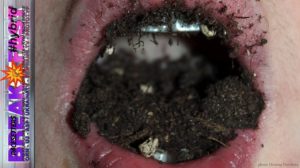
Pacesetters Hybrid BreakFast Kraków – Kyiv special Efir UKRAiANTV Re:Frame.TV; ph.: Hristina Novykova, 2024
From UKRAiNATV’s perspective, a congress like this, in Poland, in 2024, should be first and foremost a space for discussing culture’s role in geopolitical shifts, our responsibility for regional changes and global crises, and climate changes, migration, and linguistic, cultural, and intersectoral relations. We should talk about cooperatives, self-organization, and the interplay between creative industries and traditional art, as well as the institutional infrastructure of culture… Only after mapping all this out in a multidimensional, multilingual, and scalable way can we revisit debates about working conditions in institutions.
Right now, large groups of people creating culture in this country do not have access to institutional programs—or the programs don’t address them—because they’re exclusively in Polish. So, when some Gen-Z queer individual tells me something about inclusivity, I ask if their last project included descriptions in Polish, English, and Ukrainian. Were there participants of different linguistic backgrounds? Different roots? Different ages? Ageism, after all, is the most widespread global exclusion. This invisible walls are growing, the rift deepening, and with it comes real physical violence on the streets and symbolic violence in the info-sphere.
Finally, from the perspective of media art and critical media culture, we must critique the growing conservative turn within the art field—extinction art. Art institutions was or still are obliged to forge new tools and discourses around emergent phenomena that don’t fit into traditional exhibition schemes. They shouldn’t force everything into gallery formats. Let me repeat this: there is a vast amount of creativity in contemporary society—especially outside the art field (and perhaps even beyond the broader realm of institutionalized and commodified so-called culture).
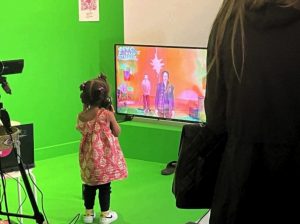
NYC UKRAiNATV POP-UP Studio x Special Efir (State of Emergence Exhibition), 2023
* * *
I need to add this, at the end… I’m piecing together these threads in Kyiv, after a week spent in northeastern Ukraine, where the ground was shaking from rocket explosions. From this vantage point, all this prehistory feels like some egocentric narrative about the remnants of a calm world in privileged, semi-provincial (read: perpetually dissatisfied) Poland, within the crystal palace of the European Union. Everything seems even more tangled and complex now. Different issues feel pressing and decisive for what we want—or need—to do in the immediate and distant future. I’m in a mid of transformation (into a monster). It’s as though I’m recounting someone else’s story, about something that happened long, long ago, which taught no one anything.
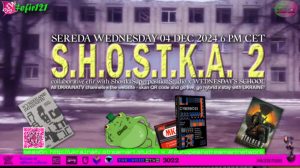
UKRAiNATV #EFIR121 Cover, S.H.O.S.T.K.A. 2, 2024


